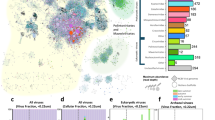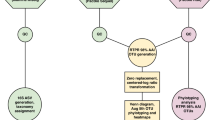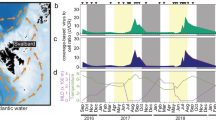Abstract
Viral diversity has been studied in a variety of marine habitats and spatial and seasonal changes have been documented. Most of the bacteriophages are considered host specific and are thought to affect fast growing prokaryotic phylotypes more than slow growing ones. We hypothesized that viral infection and consequently, lysis occurs in pulses with only a few prokaryotic phylotypes lysed at any given time. Thus, we propose that the newly produced viruses represent only a fraction of the viral diversity present at any given time. Virioplankton diversity was assessed by pulsed-field gel electrophoresis in the surface waters of three distinct areas of the North Sea during the spring and summer. Bulk virioplankton diversity was fairly stable in these waters. Viral diversity produced by the indigenous bacterioplankton, however, exhibited day-to-day variability with only a few bands produced at any given time. These bands frequently matched bands of the in situ virioplankton; however, bands not present in the band pattern of the in situ virioplankton community were also found. These new bands probably indicate infection and subsequent release of viruses from bacterioplankton phylotypes previously not infected by these specific viruses. Overall, our results demonstrate that viral infection and lysis are rather dynamic processes. The main targets of viral infection are changing apparently on time scales of hours to days indicating that viral infection might effectively regulate and maintain bacterioplankton diversity.
Similar content being viewed by others
Log in or create a free account to read this content
Gain free access to this article, as well as selected content from this journal and more on nature.com
or
References
Ackermann HW . (1987). Bacteriophage taxonomy in 1987. Microbiol Sci 4: 214–218.
Ackermann HW . (2003). Bacteriophage observations and evolution. Res Microbiol 154: 245–251.
Angly FE, Felts B, Breitbart M, Salamon P, Edwards RA, Carlson C et al. (2006). The marine viromes of four oceanic regions. PLoS Biol 4: e368.
Bergh O, Borsheim KY, Bratbak G, Heldal M . (1989). High abundance of viruses found in aquatic environments. Nature 340: 467–468.
Bettarel Y, Dolan JR, Hornak K, Lemee R, Masin M, Pedrotti ML et al. (2002). Strong, weak, and missing links in a microbial community of the NW Mediterranean Sea. FEMS Microb Ecol 42: 451–462.
Breitbart M, Salamon P, Andresen B, Mahaffy JM, Segall AM, Mead D et al. (2002). Genomic analysis of uncultured marine viral communities. Proc Natl Acad Sci USA 99: 14250–14255.
Brussaard CPD . (2004). Optimization of procedures for counting viruses by flow cytometry. Appl Environ Microbiol 70: 1506–1513.
Chen F, Suttle CA . (1995). Amplification of DNA-polymerase gene fragments from viruses infecting microalgae. Appl Environ Microbiol 61: 1274–1278.
Chen F, Suttle CA, Short SM . (1996). Genetic diversity in marine algal virus communities as revealed by sequence analysis of DNA polymerase genes. Appl Environ Microbiol 62: 2869–2874.
Dice LR . (1945). Measures of the amount of ecologic association between species. Ecology 26: 297–302.
Heldal M, Bratbak G . (1991). Production and decay of viruses in aquatic environments. Mar Ecol Prog Ser 72: 205–212.
Helton RR, Cottrell MT, Kirchman DL, Wommack KE . (2005). Evaluation of incubation-based methods for estimating virioplankton production in estuaries. Aquat Microb Ecol 41: 209–219.
Hewson I, Fuhrman JA . (2006). Improved strategy for comparing microbial assemblage fingerprints. Microb Ecol 51: 147–153.
Hewson I, O'Neil JM, Fuhrman JA, Dennison WC . (2001). Virus-like particle distribution and abundance in sediments and overlying waters along eutrophication gradients in two subtropical estuaries. Limnol Oceanogr 46: 1734–1746.
Hwang CY, Cho BC . (2002). Virus-infected bacteria in oligotrophic open waters of the East Sea, Korea. Aquat Microb Ecol 30: 1–9.
Jiang S, Fu W, Chu W, Fuhrman JA . (2003). The vertical distribution and diversity of marine bacteriophage at a station off Southern California. Microb Ecol 45: 399–410.
Klieve AV, Bauchop T . (1988). Morphological diversity of ruminal bacteriophages from sheep and cattle. Appl Environ Microbiol 54: 1637–1641.
Lanoil BD, Carlson CA, Giovannoni SJ . (2000). Bacterial chromosomal painting for in situ monitoring of cultured marine bacteria. Environ Microbiol 2: 654–665.
Ludwig JA, Reynolds JF . (1988). Statistical Ecology, a Primer on Methods and Computing. Wiley Inc: New York.
Magurran AE . (1995). Ecological Diversity and its Measurement. Princeton University: Princeton, New Jersey, USA.
Marie D, Brussaard CPD, Thyrhaug R, Bratbak G, Vaulot D . (1999). Enumeration of marine viruses in culture and natural samples by flow cytometry. Appl Environ Microbiol 65: 45–52.
Moebus K . (1980). A method for the detection of bacteriophages from ocean water. Helgol Meeresunters 34: 1–14.
Noble RT, Fuhrman JA . (2000). Rapid virus production and removal as measured with fluorescently labeled viruses as tracers. Appl Environ Microbiol 66: 3790–3797.
Paul JH (ed.) (2001). Methods in Microbiology, Marine Microbiology. Academic Press: London, UK.
Paul JH, Jiang SC, Rose JB . (1991). Concentration of viruses and dissolved DNA from aquatic environments by vortex flow filtration. Appl Environ Microbiol 57: 2197–2204.
Riemann L, Middelboe M . (2002). Stability of bacterial and viral community compositions in Danish coastal waters as depicted by DNA fingerprinting techniques. Aquat Microb Ecol 27: 219–232.
Steward GF, Cochlan WP, Smith DC, Azam F . (1992). Estimation of virus production in the sea: II. field results. Mar Microb Food Webs 6: 79–90.
Steward GF, Montiel JL, Azam F . (2000). Genome size distributions indicate variability and similarities among marine viral assemblages from diverse environments. Limnol Oceanogr 45: 1697–1706.
Steward GF, Smith DC, Azam F . (1996). Abundance and production of bacteria and viruses in the Bering and Chukchi Seas. Mar Ecol Progr Ser 131: 287–300.
Suttle CA, Chan AM . (1994). Dynamics and distribution of cyanophages and their effect on marine Synechococcus spp. Appl Environ Microbiol 60: 3167–3174.
Thingstad TF, Lignell R . (1997). Theoretical models for the control of bacterial growth rate, abundance, diversity and carbon demand. Aquat Microb Ecol 13: 19–27.
Weinbauer MG . (2004). Ecology of prokaryotic viruses. FEMS Microbiol Rev 28: 127–181.
Weinbauer MG, Brettar I, Höfle MG . (2003). Lysogeny and virus-induced mortality of bacterioplankton in surface, deep, and anoxic marine waters. Limnol Oceanogr 48: 1457–1465.
Weinbauer MG, Suttle CA . (1996). Potential significance of lysogeny to bacteriophage production and bacterial mortality in coastal waters of the Gulf of Mexico. Appl Environ Microbiol 62: 4374–4380.
Whittaker RH . (1952). A study of summer foliage insect communities in the Great Smoky Mountains. Ecological Monogr 22: 1–44.
Wilhelm SW, Brigden SM, Suttle CA . (2002). A dilution technique for the direct measurement of viral production: a comparison in stratified and tidally mixed coastal waters. Microb Ecol 43: 168–173.
Wilhelm SW, Weinbauer MG, Suttle CA, Jeffrey WH . (1998). The role of sunlight in the removal and repair of viruses in the sea. Limnol Oceanogr 43: 586–592.
Williamson SJ, McLaughlin MR, Paul JH . (2001). Interaction of the Phi HSIC virus with its host: lysogeny or pseudolysogeny? Appl Environ Microbiol 67: 1682–1688.
Winget DM, Williamson KE, Helton RR, Wommack KE . (2005). Tangential flow diafiltration: an improved technique for estimation of virioplankton production. Aquat Microb Ecol 41: 221–232.
Winter C, Herndl GJ, Weinbauer MG . (2004). Diel cycles in viral infection of bacterioplankton in the North Sea. Aquat Microb Ecol 35: 207–216.
Wommack KE, Ravel J, Hill RT, Chun JS, Colwell RR . (1999a). Population dynamics of Chesapeake Bay virioplankton: total-community analysis by pulsed-field gel electrophoresis. Appl Environ Microbiol 65: 231–240.
Wommack KE, Ravel J, Hill RT, Colwell RR . (1999b). Hybridization analysis of Chesapeake Bay virioplankton. Appl Environ Microbiol 65: 241–250.
Acknowledgements
We thank Corina Brussaard for inviting us to join her cruise and the captain and the crew of the R/V Pelagia for their splendid support and atmosphere on board. The Dutch Marine Research Facilities provided excellent logistic support. Research was supported by two grants from the Dutch Science Foundation, Earth and Life Sciences branch (NWO-ALW project nos. 835.20.023 and 812.03.001. This paper is in partial fulfillment of the requirements for a PhD degree from the University of Groningen by V.P. The work was carried out within the frame of the ‘Networks of Excellence’ MarBef and EurOceans supported by the 6th Framework Program of the European Union.
Author information
Authors and Affiliations
Corresponding author
Rights and permissions
About this article
Cite this article
Parada, V., Baudoux, AC., Sintes, E. et al. Dynamics and diversity of newly produced virioplankton in the North Sea. ISME J 2, 924–936 (2008). https://doi.org/10.1038/ismej.2008.57
Received:
Revised:
Accepted:
Published:
Issue date:
DOI: https://doi.org/10.1038/ismej.2008.57
Keywords
This article is cited by
-
Oral Toxicity Study for Salmonella Killing Lytic Bacteriophage NINP13076 in BALB/c Mice and Its Effect on Probiotic Microbiota
Current Microbiology (2022)
-
A novel phage from periodontal pockets associated with chronic periodontitis
Virus Genes (2019)
-
Human oral viruses are personal, persistent and gender-consistent
The ISME Journal (2014)
-
Variations in Abundance, Genome Size, Morphology, and Functional Role of the Virioplankton in Lakes Annecy and Bourget over a 1-Year Period
Microbial Ecology (2014)
-
Diurnal variations in bacterial and viral production in Cochin estuary, India
Environmental Monitoring and Assessment (2013)



